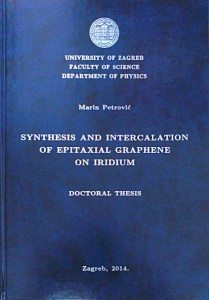In October 2014, I successfully defended my Ph.D. thesis entitled Synthesis and intercalation of epitaxial graphene on iridium. Its extended abstract is given here and the complete thesis (pdf, ~23 MB) can be downloaded by clicking on the front cover image below.
 Epitaxial graphene on iridium (111) surface is considered to be one of the best systems for studying intrinsic properties of graphene due to the weak interaction with the substrate which is predominantly of the van der Waals character. In epitaxial systems, graphene’s properties can be modified or some new ones can be induced by the processes of intercalation of various atoms or molecules in between the graphene and the substrate. Therefore, a detailed understanding of the formation of such hybrid systems, from graphene synthesis to its intercalation, is crucial for their complete understanding.
Epitaxial graphene on iridium (111) surface is considered to be one of the best systems for studying intrinsic properties of graphene due to the weak interaction with the substrate which is predominantly of the van der Waals character. In epitaxial systems, graphene’s properties can be modified or some new ones can be induced by the processes of intercalation of various atoms or molecules in between the graphene and the substrate. Therefore, a detailed understanding of the formation of such hybrid systems, from graphene synthesis to its intercalation, is crucial for their complete understanding.
In this thesis, results relevant for the growth and intercalation of epitaxial graphene synthesized on Ir(111) are presented. By utilizing well-established procedures for graphene synthesis, samples with various graphene coverages are prepared in order to characterize the growth of graphene in detail. Different species (specifically, Cs, Li, Eu and O) are also deposited on such samples which results in the formation of new, hybrid (and most often intercalated) systems whose properties depend on the exact preparation parameters. In order to characterize the morphology, low energy electron microscopy (LEEM) and scanning tunneling microscopy (STM) are used while the electronic structure is investigated by means of angle-resolved photoemission spectroscopy (ARPES) and two-photon photoemission spectroscopy (2PPE). The growth of graphene is characterized on a microscopic level, focusing on small graphene islands and their interaction with iridium. For a complete graphene monolayer, a network of graphene wrinkles is studied. It is found that such network exhibits ordering on the micrometer scales dictated by the substrate. Occupied and unoccupied electronic structure in the vicinity of the Brillouin zone center is investigated via spectroscopic techniques establishing basic relations between the states located below and above the Fermi level. From the aspect of intercalation, Cs deposition on well defined graphene layer is studied and emerging spectroscopic and morphological features are characterized. By this, a novel mechanism of intercalation and the corresponding dynamics behind it are revealed. A competition between Coulomb and van der Waals interactions turns out to be crucial in such epitaxial systems. In addition, intercalation of Li, Eu and O are characterized with special emphasis on the electronic structure at the K point of the Brillouin zone which gives new insight on the influence of various intercalated layers on the surface states of iridium.
